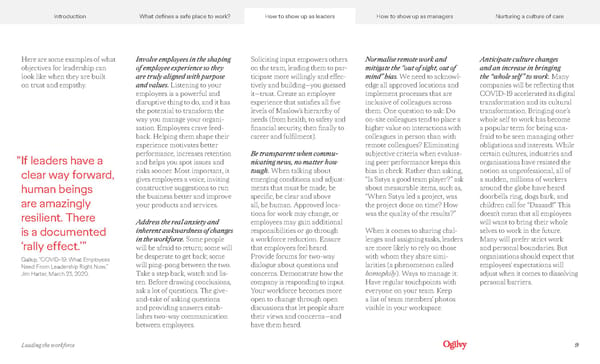Introduction What defines a safe place to work? How to show up as managers Nurturing a culture of care Introduction What defines a safe place to work? How to show up as leaders How to show up as managers Nurturing a culture of care Here are some examples of what Involve employees in the shaping Soliciting input empowers others Normalise remote work and Anticipate culture changes objectives for leadership can of employee experience so they on the team, leading them to par- mitigate the “out of sight, out of and an increase in bringing look like when they are built are truly aligned with purpose ticipate more willingly and effec- mind” bias. We need to acknowl- the “whole self” to work. Many on trust and empathy. and values. Listening to your tively and building—you guessed edge all approved locations and companies will be reflecting that employees is a powerful and it—trust. Create an employee implement processes that are COVID-19 accelerated its digital disruptive thing to do, and it has experience that satisfies all five inclusive of colleagues across transformation and its cultural the potential to transform the levels of Maslow’s hierarchy of them. One question to ask: Do transformation. Bringing one’s way you manage your organi- needs (from health, to safety and on-site colleagues tend to place a whole self to work has become sation. Employees crave feed- financial security, then finally to higher value on interactions with a popular term for being una- back. Helping them shape their career and fulfilment). colleagues in person than with fraid to be seen managing other experience motivates better remote colleagues? Eliminating obligations and interests. While performance, increases retention Be transparent when commu- subjective criteria when evaluat- certain cultures, industries and “ If leaders have a and helps you spot issues and nicating news, no matter how ing peer performance keeps this organisations have resisted the clear way forward, risks sooner. Most important, it tough. When talking about bias in check. Rather than asking, notion as unprofessional, all of gives employees a voice, inviting emerging conditions and adjust- “Is Satya a good team player?” ask a sudden, millions of workers human beings constructive suggestions to run ments that must be made, be about measurable items, such as, around the globe have heard the business better and improve specific, be clear and above “When Satya led a project, was doorbells ring, dogs bark, and are amazingly your products and services. all, be human. Approved loca- the project done on time? How children call for “Daaaad!” This resilient. There tions for work may change, or was the quality of the results?” doesn’t mean that all employees Address the real anxiety and employees may gain additional will want to bring their whole is a documented inherent awkwardness of changes responsibilities or go through When it comes to sharing chal- selves to work in the future. in the workforce. Some people a workforce reduction. Ensure lenges and assigning tasks, leaders Many will prefer strict work ‘rally effect.’” will be afraid to return; some will that employees feel heard. are more likely to rely on those and personal boundaries. But be desperate to get back; some Provide forums for two-way with whom they share simi- organisations should expect that Gallup, “COVID-19: What Employees will ping-pong between the two. dialogue about questions and larities (a phenomenon called employees’ expectations will Need From Leadership Right Now,” Jim Harter, March 23, 2020. Take a step back, watch and lis- concerns. Demonstrate how the homophily). Ways to manage it: adjust when it comes to dissolving ten. Before drawing conclusions, company is responding to input. Have regular touchpoints with personal barriers. ask a lot of questions. The give- Your workforce becomes more everyone on your team. Keep and-take of asking questions open to change through open a list of team members’ photos and providing answers estab- discussions that let people share visible in your workspace. lishes two-way communication their views and concerns—and between employees. have them heard. Leading the workforce 9
 New Way of Working Page 8 Page 10
New Way of Working Page 8 Page 10